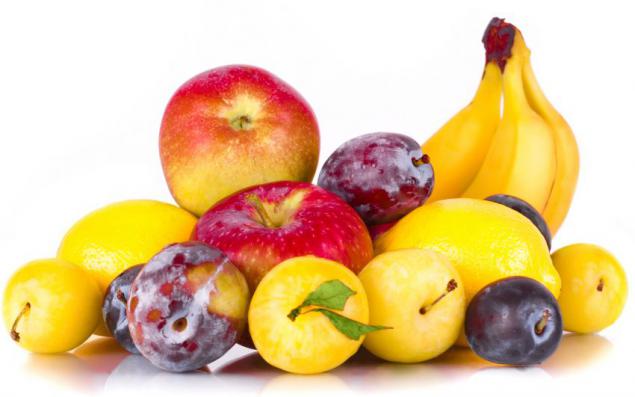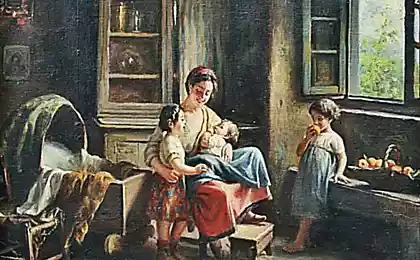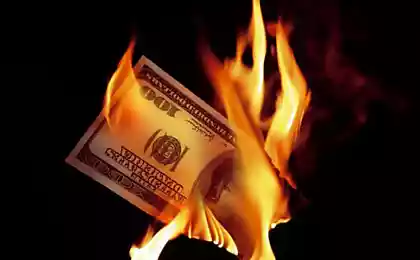953
Alternative monetary currency
As the famous saying goes, "money can not buy happiness," but it is the money to help him gain. Especially if they can create yourself, and easy to get. In some places and even entire countries increasingly popular local 'currency »

Fresh fruits. In prison for teenagers in the UK as an alternative currency with fresh fruit. Criminals older sorts of offerings are made in the form of bananas, apples and other fruits that are in prison a large deficit. To remedy the situation, and to destroy this underground market, non-governmental organization "Howard League for Penal Reform" proposed to flood its "scarce commodity" - in other words, to give young prisoners more fruit.

Detergent «Tide» It is called "liquid gold" This is probably the most unusual method of calculation: criminals use Tide detergent instead of money for buying and selling drugs. There are many reasons: the brand fairly well-known, easy to steal items from any retail store, and it can threaten only a relatively lightweight paper for shoplifting. All this in the criminal world of America Liquid Tide is an alternative currency for the thirsty to buy a dose. In New York, a bottle of 150 ounces (4, 4 liters) goes for five dollars in cash and ten dollars marijuana or crack.

Canadian Tyra. In Canada, more than half a century, along with the Canadian dollar, there is another form of hard currency, the company that prints Canadian Tire (retail chain that sells a variety of products, from car tires to kitchen utensils). Bright paper with a picture of Sandy MakTayra par value of five cents to two Canadian dollars began printing in 1958. They acted as discount coupons online shopping Canadian Tire. However, due to the popularity of these stores began to take notes, and many other places. Now they quietly can pay at the bar or bistro almost throughout the country. Speculators buy and sell them to collectors hunt for rare specimens, and counterfeiters are trying to sell fake Tyra.

Kimgauer. Economics teacher from Germany came up with an interesting way to explain to his students his subject - in 2003, he presented his own currency, which he called "kimagauer» («Chiemgauer»). Kimagauer exchanged for euros at the rate of 1: 1, but each quarter with the owner of the money is taxed at a rate of 2% (ie 8% per year) - to pay for the tax acquired stickers affixed to the bill. Therefore, holders of kimgauerov try as quickly as possible to exchange them for goods and services. Accumulating such currency turns unprofitable. Kimagauery are very popular in the south of Germany, they are found around 600 companies and are taking more than 300 stores. In 2010 it was exchanged kimagauery 5, 1 million euros.

Wen - "green" global currency. Wen (Ven) - the first digital currency with a freely fluctuating exchange rate. Participants network Hub Culture use it for the purchase of physical goods and services. This is the only means of payment, which take in the pavilions of Hub Culture, located in many cities around the world. Without going into the intricacies of economic, say only that the course of Vienna is tied to a basket of currencies and weighted average prices for coal, so it is much more stable than any single currency.

Franks WIR. This is one of the first brands Franca WIR, 1936 Francs WIR (in German "we") - one of the oldest and most successful alternative currencies. Their story began in 1934 in response to the Great Depression. 16 entrepreneurs - clients of the bank WIR gathered and created its own payment system for mutual settlements for goods and services among themselves. WIR Bank has provided loans to its clients in its own francs bail material possessions so that they can pay these Franks with other clients of the bank WIR. Now Franks WIR uses more than 60 000 enterprises to small and medium-sized businesses.

Experiment "Bitkoinovy marriage." Today, there are a number of alternative digital currencies, but the largest still remains Bitcoin. What is e-currency? In fact, the international payment system, no matter what the state of the bank, company or any other entity. In an ideal world, such a system of payment would be the most convenient and cheap. But in reality, with the purchase, sale and use of Bitcoin is there are big problems. Newlyweds from the US state of Utah Austin and Becky Bingham decided to conduct an experiment and the first 90 days of life to live together without using any money, except for Bitcoins. At the moment, the experiment continues, and young people take it on a documentary. However, it is now clear that there is a place where they take Bitcoins task is not easy.

L $ - real currency of the virtual world. This currency is called «Linden Dollars» (abbreviated as L $). It operates in the virtual community known as the «Second Life». Where users create characters (a virtual version of themselves), interact with other characters and can conduct business using the most virtual currency L $. Earned L $ can be converted into real dollars - their rate fluctuates, but currently 250 virtual dollars can be exchanged for a real one. That is, you can get rich just by playing a computer game, which many do. The most famous resident of Second Life became Anshi Chang (in the real world - a German teacher of Chinese descent Eileen Gref). She - the first ever to make real, the real one million dollars in the virtual world. His condition Anshi made by selling virtual real estate. In the early days of Second Life, it has invested in this strange company of 9, $ 95, began to gain virtual sites, "build" on their houses and gardens to break, and then exhibited "real estate" for sale. Today Gref profits from games of 150 thousand dollars a year.

Source: dymontiger.livejournal.com

Fresh fruits. In prison for teenagers in the UK as an alternative currency with fresh fruit. Criminals older sorts of offerings are made in the form of bananas, apples and other fruits that are in prison a large deficit. To remedy the situation, and to destroy this underground market, non-governmental organization "Howard League for Penal Reform" proposed to flood its "scarce commodity" - in other words, to give young prisoners more fruit.

Detergent «Tide» It is called "liquid gold" This is probably the most unusual method of calculation: criminals use Tide detergent instead of money for buying and selling drugs. There are many reasons: the brand fairly well-known, easy to steal items from any retail store, and it can threaten only a relatively lightweight paper for shoplifting. All this in the criminal world of America Liquid Tide is an alternative currency for the thirsty to buy a dose. In New York, a bottle of 150 ounces (4, 4 liters) goes for five dollars in cash and ten dollars marijuana or crack.

Canadian Tyra. In Canada, more than half a century, along with the Canadian dollar, there is another form of hard currency, the company that prints Canadian Tire (retail chain that sells a variety of products, from car tires to kitchen utensils). Bright paper with a picture of Sandy MakTayra par value of five cents to two Canadian dollars began printing in 1958. They acted as discount coupons online shopping Canadian Tire. However, due to the popularity of these stores began to take notes, and many other places. Now they quietly can pay at the bar or bistro almost throughout the country. Speculators buy and sell them to collectors hunt for rare specimens, and counterfeiters are trying to sell fake Tyra.

Kimgauer. Economics teacher from Germany came up with an interesting way to explain to his students his subject - in 2003, he presented his own currency, which he called "kimagauer» («Chiemgauer»). Kimagauer exchanged for euros at the rate of 1: 1, but each quarter with the owner of the money is taxed at a rate of 2% (ie 8% per year) - to pay for the tax acquired stickers affixed to the bill. Therefore, holders of kimgauerov try as quickly as possible to exchange them for goods and services. Accumulating such currency turns unprofitable. Kimagauery are very popular in the south of Germany, they are found around 600 companies and are taking more than 300 stores. In 2010 it was exchanged kimagauery 5, 1 million euros.

Wen - "green" global currency. Wen (Ven) - the first digital currency with a freely fluctuating exchange rate. Participants network Hub Culture use it for the purchase of physical goods and services. This is the only means of payment, which take in the pavilions of Hub Culture, located in many cities around the world. Without going into the intricacies of economic, say only that the course of Vienna is tied to a basket of currencies and weighted average prices for coal, so it is much more stable than any single currency.

Franks WIR. This is one of the first brands Franca WIR, 1936 Francs WIR (in German "we") - one of the oldest and most successful alternative currencies. Their story began in 1934 in response to the Great Depression. 16 entrepreneurs - clients of the bank WIR gathered and created its own payment system for mutual settlements for goods and services among themselves. WIR Bank has provided loans to its clients in its own francs bail material possessions so that they can pay these Franks with other clients of the bank WIR. Now Franks WIR uses more than 60 000 enterprises to small and medium-sized businesses.

Experiment "Bitkoinovy marriage." Today, there are a number of alternative digital currencies, but the largest still remains Bitcoin. What is e-currency? In fact, the international payment system, no matter what the state of the bank, company or any other entity. In an ideal world, such a system of payment would be the most convenient and cheap. But in reality, with the purchase, sale and use of Bitcoin is there are big problems. Newlyweds from the US state of Utah Austin and Becky Bingham decided to conduct an experiment and the first 90 days of life to live together without using any money, except for Bitcoins. At the moment, the experiment continues, and young people take it on a documentary. However, it is now clear that there is a place where they take Bitcoins task is not easy.

L $ - real currency of the virtual world. This currency is called «Linden Dollars» (abbreviated as L $). It operates in the virtual community known as the «Second Life». Where users create characters (a virtual version of themselves), interact with other characters and can conduct business using the most virtual currency L $. Earned L $ can be converted into real dollars - their rate fluctuates, but currently 250 virtual dollars can be exchanged for a real one. That is, you can get rich just by playing a computer game, which many do. The most famous resident of Second Life became Anshi Chang (in the real world - a German teacher of Chinese descent Eileen Gref). She - the first ever to make real, the real one million dollars in the virtual world. His condition Anshi made by selling virtual real estate. In the early days of Second Life, it has invested in this strange company of 9, $ 95, began to gain virtual sites, "build" on their houses and gardens to break, and then exhibited "real estate" for sale. Today Gref profits from games of 150 thousand dollars a year.

Source: dymontiger.livejournal.com
























